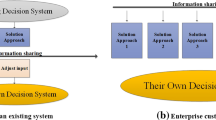Abstract
In our research, we study the case of a pulp and paper producer who decides to establish a partnership with one buyer. Using two different types of relationship, namely a traditional system without any collaboration scheme and Collaborative Planning, Forecasting and Replenishment, we develop decision models describing the producer and the buyer planning processes. We also identify which approach is more profitable for each actor as well as for the network, based on real costs and parameters obtained from the industrial case. We then test how different incentives can improve the traditional system and provide higher gains for each partner. Our results show that using incentives increases the system's profit by up to 4% if parameters are well defined.

















Similar content being viewed by others
References
Barratt M and Oliveira A (2001). Exploring the experiences of collaborative planning initiatives . Int J Phys Distrib Logist Mngt 31(4): 266–289.
Bernstein F and Federgruen A (2005). Decentralized supply chains with competing retailers under demand uncertainty . Mngt Sci 50(1): 18–29.
Cachon GP (2003). Supply chain coordination with contracts . In: de Kok AG and Graves SC (eds). Handbooks in Operations Research and Management Science, Vol. 11. Elsevier: Amsterdam, pp. 229–339.
Cachon GP (2004). The allocation of inventory risk in a supply chain: Push, pull, and advance-purchase discount contracts . Mngt Sci 50(2): 222–238.
Carlsson D, D'Amours S, Martel A and Rönnqvist M (2006). Supply chain management in the pulp and paper industry. CIRRELT Working Paper DT-2006-AM-3, Laval University, Canada.
Chauhan SS, Martel A and D'Amours S (2008). Roll assortment optimization in a paper mill: An integer programming approach . Comput Opns Res 35(2): 614–627.
Chen F (2003). Information sharing and supply chain coordination . In: de Kok AG and Graves SC (eds). Handbooks in Operations Research and Management Science, Vol. 11. Elsevier: Amsterdam, pp. 341–421.
Cheng TCE and Wu YN (2005). The impact of information sharing in a two-level supply chain with multiple retailers . J Opl Res Soc 56: 1159–1165.
Cigolini R and Rossi T (2006). A note on supply risk and inventory outsourcing . Prod Plan Control 17(4): 424–437.
De Toni AF and Zamolo E (2005). From a traditional replenishment system to vendor-managed inventory: A case study from the household electrical appliances sector . Int J Prod Econ 96: 63–79.
Dudek G and Stadtler H (2007). Negotiation-based collaborative planning in divergent two-tier supply chains . Int J Prod Res 45(2): 465–484.
Giannoccaro I and Pontrandolfo P (2004). Supply chain coordination by revenue sharing contracts . Int J Prod Econ 89: 131–139.
Jung H, Jeong B and Lee C-G (2008). An order quantity negotiation model for distributor-driven supply chains . Int J Prod Econ 111: 147–158.
Lee HL, Padmanabhan and Whang VS (1997). Information distortion in supply chain: The bullwhip effect . Mngt Sci 43(4): 546–558.
Lehoux N, D'Amours S and Langevin A (2007). Collaboration and decision models for a two-echelon supply chain: A case study in the pulp and paper industry. Working paper CIRRELT-2007-38, Laval University, Canada.
Lehoux N, D'Amours S and Langevin A (2008). Dynamique des relations interentreprises: Mécanismes, barrières et cas pratique . Revue Française de Gestion Industrielle 27(4): 1–25.
Martel A (2000). Conception et gestion de chaînes logistiques. Operation and Decision System Department, Laval University, Canada.
Munson CL and Rosenblatt MJ (2001). Coordinating three-level supply chain with quantity discount . IIE T 33(5): 371–385.
Rizk N, Martel A and D'Amours S (2008). Synchronized production–distribution planning in a single-plant multi-destination network . J Opl Res Soc 59: 90–104.
Simatupang TM and Sridharan R (2002). The collaborative supply chain . Int J Logist Mngt 13(1): 15–30.
Thron T, Nagy G and Wassan N (2005). The impact of various delivery prioritization strategies in heterogeneous supply chain environments. In: Proceedings of the 3rd International Industrial Simulation Conference, Eurosis-ETI: Ghent, pp 262–268.
Tsay AA (1999). The quantity flexibility contract and supplier–customer incentives . Mngt Sci 45(10): 1339–1358.
Urban TL (2007). The effect of margin guarantees on pricing and production . Int J Manuf Technol Mngt 12(4): 314–326.
van der Vlist P (2007). Synchronizing the Retail Supply Chain. PhD Thesis, Erasmus University Rotterdam, Rotterdam.
VICS (2004). CPFR Guidelines, http://www.vics.org/home, accessed 30 January 2009.
Yu Z, Yan H and Cheng TCE (2002). Modelling the benefits of information sharing-based partnerships in a two-level supply chain . J Opl Res Soc 53: 436–446.
Zhu B-L, Yu H-B and Huang X-Y (2007). Integrated production planning model and method for supply chain. In: Proceedings of the International Conference on Wireless Communications, Networking and Mobile Computing, Piscataway: NJ, pp 4709–4712.
Author information
Authors and Affiliations
Corresponding author
Rights and permissions
About this article
Cite this article
Lehoux, N., D'Amours, S., Frein, Y. et al. Collaboration for a two-echelon supply chain in the pulp and paper industry: the use of incentives to increase profit. J Oper Res Soc 62, 581–592 (2011). https://doi.org/10.1057/jors.2009.167
Received:
Accepted:
Published:
Issue Date:
DOI: https://doi.org/10.1057/jors.2009.167




